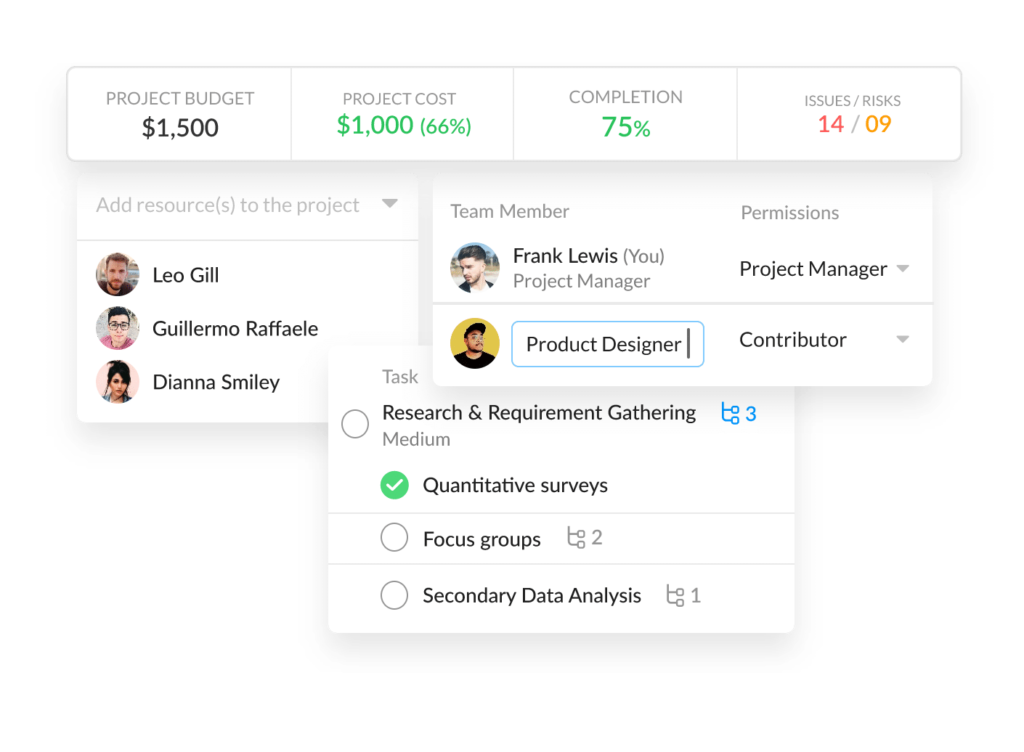The degree to which a resource, alongside resource availability, may be accessed is an essential factor in resource management.
When selecting how to distribute and allot the appropriate assets for a particular project, one of the most significant considerations to consider is how well one is aware of the resources accessible at any one time.
How can you plan to construct anything like a bridge, for instance, if you don’t know how many people are available to work on the project? However, managing resources is about more than just the people involved.

When we speak of resources, we are referring to the following things:
- Management of individuals and teams
- Funding – i.e budget management
- Material assets consist of everything else, from tools and machinery to equipment and space, that must be accumulated to successfully carry out a project from its inception to its conclusion
The fact that it can be challenging to bring all of these distinct aspects together is one of the primary reasons why resource management has the reputation of being a difficult profession.
Project managers have little chance of arriving at accurate estimates of the length of time that a project may take, as well as the number of people, the amount of money, and the material assets that will be required for the project if they do not have access to the necessary planning and analytics tools.
Resource management
made easy and simple!

Without tools that can lay out these aspects, managers cannot account for all of the necessary details, which increases the likelihood that chances will be missed.
This can result in project managers missing deadlines or running over budget, which will, in the end, cost their firm money and may ruin its reputation with consumers and clients.
What is Resource Availability?
The knowledge that a project management team has regarding the resources they can utilize on a project, when they can use these materials or expertise and whether or not there are any specific conditions to meet is referred to as resource availability.
The term “resource” most often refers to the individuals participating in the project; however, it can also apply to other types of resources, such as equipment, space, and human labor.
When resources are the personnel that leaders assign to a project, having available resources requires understanding exactly how each person involved in the project uses their working time over the life of a project and when they have time off from the project.
The availability of resources is typically weighed against project management teams’ demand for those resources. Resource demand refers to the total number of resources a team needs to complete a project.
While it may be difficult to correctly foresee the exact demand for resources that a project will have, having control over the availability of those resources can provide a project manager the flexibility they need to strike a balance between the two.

Advantages of Balancing Resource Availability
Getting the supply and demand for resources in the right proportions can have several major benefits, including the following:
* Improved decision-making
It is possible to improve the quality of the judgments you make on resource utilization if you have accurate information regarding the resources available for the project and an estimate of the demand for those resources.
It can also assist you in deciding whether or not to begin a new project, as having all of your resources taken up often indicates that you will need more resources to start a new project if you already have all of your resources taken up.
* Streamlines the process of adjusting to the shifting requirements of a project
During completion, projects typically experience shifts in their scope and total requirements. Suppose you have control over the availability of the resources. In that case, it will be easier for you to determine whether or not you have the resources to broaden the project scope by including more crucial components.
* Lowers the likelihood of conflicts over resources between different organizations
When numerous projects are being worked on simultaneously, as with some businesses, this frequently results in an internal struggle for resources, which can cause initiatives to fail.
Because they are aware of and in charge of the organization’s available resources, the management team can distribute them most efficiently.
* Assists in optimizing the workload of your employees
Depending on the amount of labor expected of each employee in a specific activity, some workers may have feelings of overwork. In contrast, others may be forced to do nothing but wait for their turn to contribute.
The proper allocation of the working time of the project management team can be facilitated by minimizing this issue through resource availability balancing.
* Enables you to establish reasonable goals and objectives
It is essential for a project manager to effectively manage the expectations that clients and other stakeholders may have regarding the outcome of a project.
You can use the information to help determine the project’s scope and deadline if you know your available resources. This can help set more reasonable expectations for the deliverables that you will produce.
* Offers data in preparation for upcoming projects
Finding out what resources are available for a project and figuring out how to balance those resources with the project’s needs might be helpful information for future initiatives.
You can utilize the resource management analysis for the current project as a guide when determining the resource availability for the next project if the two projects share similar characteristics. This can be done by comparing the two projects.
* Assists in facing unforeseen difficulties
While finishing a project, various unforeseen occurrences might occur, which can increase the time and resources needed.
Suppose there is a healthy supply of resources. In that case, you will be better positioned to weather unexpected challenges because you can reallocate those resources to meet the higher demand.

How to keep track of the availability of resources when managing projects?
No question that having a complete picture of everyone’s schedule is beneficial. Monitoring the resources can allow you to plan your actions more effectively, whether for a specific project or the entire firm.
But the question remains: how can you track resource availability? Putting aside the theory, the following are some actions you can do to achieve the required transparency.
* Match resources to projects in one central location
Understanding your resource availability starts with visibility into your entire resource pool – specifically, who is doing what and when.
This means that resources should be connected to projects and vice versa, so here’s the first best practice for getting to know your resource availability: Match resources to projects in one central location.
You don’t want resources, projects, and tasks scattered in different places or spreadsheets. Then it becomes difficult to discern who’s working on what.
There are two ways to allocate resources for better visibility. You can either allocate them to tasks or projects. Task allocations require a lot of manual work but will fit you well if the type of work is predictable enough to plan.
In turn, project allocations will suit companies that prefer agile work.
Nevertheless, allocating people to tasks and tracking their workloads doesn’t operate on a typical Google calendar (e.g., monthly or weekly); therefore, it requires a different approach to task tracking than most people commonly use.
* Make a schedule for the available resources.
We’ve developed a Resource Schedule inside nTask that integrates with your projects and tasks to provide an all-encompassing view of the resource allocations for your entire organization’s projects and activities.
It provides visibility into a team’s projected and present workloads, which agencies desperately require.
To construct a timetable for available resources, you must first determine an estimate for each of your tasks and projects and start and end dates.
A realistic resource schedule indicates that you have counted the days available to do something, added up all of your deadlines, and then estimated how many tasks you can complete during that time frame.
This is the only way to ensure that your schedule is accurate. This very workable strategy guarantees that the planner will obtain near to the best degree of productivity attainable in every commercial circumstance.
* Visualize non-project time
Every resource calendar needs to factor in your resource’s internal time, including vacation and time off, to have a clearer picture of when your team will be absent.
If you fail to account for this time, you may overcommit resources, resulting in less free time or even tension, neither of which are desirable outcomes.
You have to become an expert in the management of available resources if you want to see an improvement in operational efficiency.
Why?
To answer your question, doing so will make it possible to determine a suitable project timeframe better and assist in avoiding conflicts in the frequent circumstances that arise when two or more committed projects require the same resource simultaneously.
How Should One Plan Their Resources?
Once a project manager has established the availability of the necessary resources, they can go on to future out how to put those resources to work to achieve the objectives outlined in their project plan.
* Consult with People Who Are Skilled in the Subject Matter
To the extent that it is practicable, consult with subject matter experts who are already familiar with the purpose and goals of your project. Do they believe that the financial and time resources allotted for this project will be sufficient to achieve the scope of work they have desired?
In addition to consulting with subject matter experts, it is also beneficial to confer with other project managers within your firm who may have experience executing projects comparable to the one elsewhere in the business.
Get in touch with these influential people to get their thoughts on the project’s resources and the best way to distribute them.
* Prepare for the Unexpected
It is not a good idea to base the entirety of your project timetable on a single action plan, even though there can be a single optimal approach to carrying out a project. Investigate any other options that could be used to accomplish the project objectives.
Suppose only one individual possesses the necessary skills to complete a specific assignment. In that case, you will need to make sure that you have a backup plan in place if something may go wrong or, more appropriately, when something goes wrong.
* Keep an eye on both the internal and external data
When I start a new project, one of the first things I do is make a baseline schedule. This allows me to monitor how closely my initial assumptions match the project’s results.
You should consult the documentation of lessons learned, such as previous project schedules, risk registers, budgets, and/or retrospectives, to assist you in allocating resources effectively in terms of money, time, and people and to help you avoid potential problems.
Conversations with other project managers can provide benefits, including a deeper understanding of individual team members’ skills and approaches to work.
This knowledge can then be used to inform the distribution of resources.
* Take a look at the theory of constraints
The theory of constraints is a management methodology that assists project managers in locating potential blockages in their work processes. This can be accomplished through the use of the theory of constraints.
Suppose these bottlenecks are not identified and removed. In that case, the capacity of your team to deliver according to the project timeline may be jeopardized by factors external to the organization.
The methodology based on the notion of constraints consists of the following five steps:
- Investigate each procedure outlined in the resource strategy for your project
- Who or what is the limiting restriction that causes progress to be slowed or stopped?
- Analyze the project’s resource use to determine which resources you have available to devote to overcoming the restriction
- Make sure that the constraint is supported by all of the activities in the process
- If the constraint can’t be removed entirely, look into other options that can help reduce its impact on the operation of the business (e.g., investing additional resources)
- Take into account the newly introduced restrictions, and carry on with the process
It would be best to consider whether your project involves other groups working together. To what extent does your team’s success depend on other teams’ contributions? These limitations may also affect your project.
To Sum It Up…
The advantages of being aware of the availability of your resources are rather obvious. It is also essential to thoroughly understand the potential influence that resource availability can present on corporate-level strategies.
But then again, we recommend keeping your ear to the ground and seeing how your competitors are evolving. We’re just about getting started with a copious amount of new challenges in the year 2024, so resource availability and management may not be as easy as it says in this post.
Feel free to improvise and make improvements to the workflow for process efficiency.

